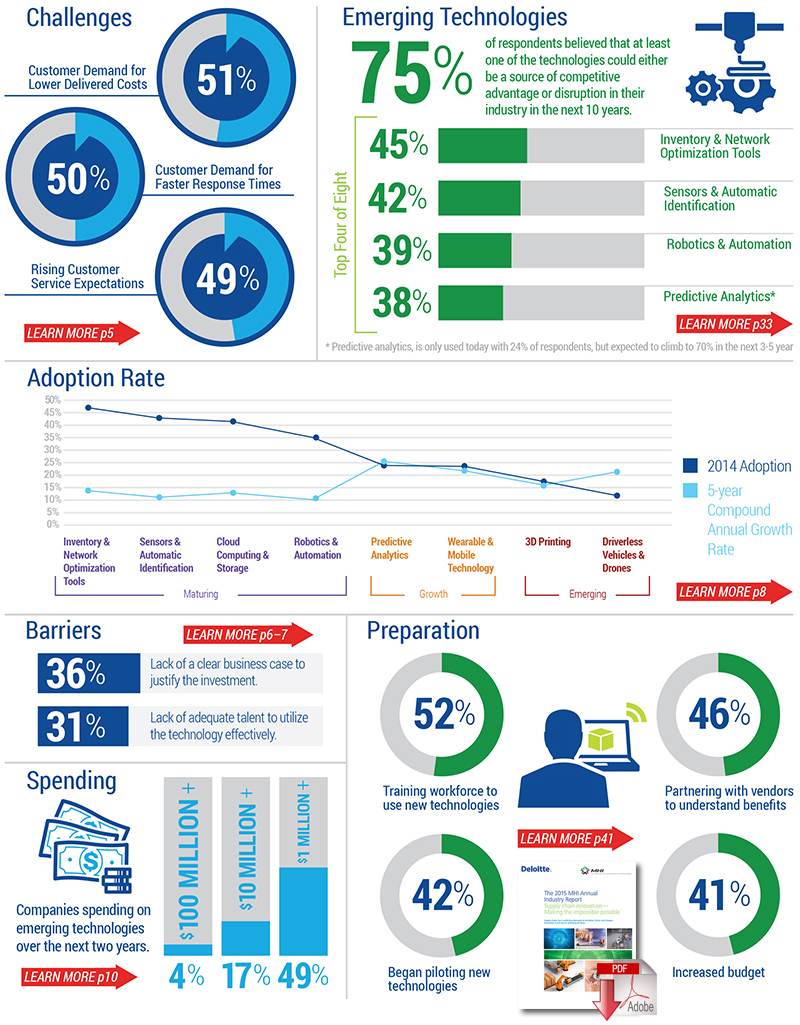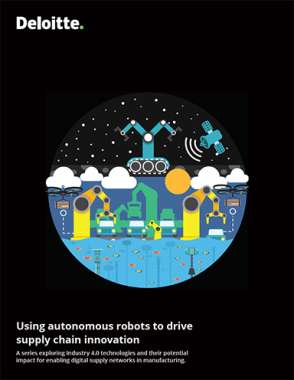MHI & Deloitte Study: Traditional Supply Chains to Undergo Radical Transformation By 2025

Innovations like predictive analytics, 3D printing, and wearable technologies are changing the supply chain landscape as workforce shortage intensifies; Customer demands and competition are the driving forces.
Traditional supply chains will radically change over the next five to 10 years as a result of new technologies, competition and customer demands, according to a new study by MHI and Deloitte.
On average, companies surveyed expect to invest heavily in new supply chain technologies over the next two years, with the top 17 percent spending over $10 million.
According to the 2015 MHI Annual Industry Report titled “Supply Chain Innovation - Making the impossible possible,” firms should embrace this transformation today and focus on investing in new technologies in order to compete and thrive as their supply chains continue to face constant pressure to do more with less.
“The speed at which supply chain innovation is being adopted–coupled with rising consumer expectations for anytime, anywhere service–is stressing traditional supply chains to near-breaking points,” said George Prest, CEO of MHI, an international trade association that represents the material handling, logistics and supply chain industry. “Companies that continue to use traditional supply chain models will struggle to remain competitive and deliver orders that are accurate and on-time.”
The second MHI Annual Industry Report identifies the realities many companies face and the disrupters that are likely to drive even more change over the next 10 years. The report was launched at MHI’s ProMat expo March 23-26 at McCormick Place South in Chicago. “Through this report, we aim to help companies identify these disruptive factors, find the best options, and make the right investments to manage their global supply chains,” said Prest.
Eight Technologies that are Reshaping the Supply Chain Landscape
The survey focused on eight technologies that are driving next-generation supply chains:
- Inventory and network optimization tools
- Sensors and automatic identification
- Cloud computing and storage
- Robotics and automation
- Predictive analytics
- Wearable and mobile technology
- 3D printing
- Driverless vehicles and drones
“I believe that we are at the dawn of an innovation wave that will soon hit the material handling industry,” says Scott Sopher, principal, Deloitte Consulting LLP. “The convergence of big data, faster and cheaper computer power, and the increasing demands of customers will likely accelerate the adoption of innovative products and services in the material handling industry.”
The report groups these innovations into three categories – maturing, growing and emerging – based on current adoption levels and anticipated adoption over the next five years.
Maturing Technologies
“Maturing technologies can create dramatic improvements in efficiency and service. For instance, inventory and network optimization tools can reduce supply chain costs by 10 percent or more, with larger potential reduction in total inventory costs,” Sopher said, referencing the study. “Current adoption levels are significant, with 35 percent or more of companies using these maturing technologies.”
- Adoption levels of these maturing technologies are expected to reach 80-90 percent by 2019.
Growth Technologies
Adoption levels for technologies such as predictive analytics and wearable and mobile technologies are only at about 20 percent, but are expected to grow significantly over the next three to five years, according to the study.
- The current adoption level of 24 percent for predictive analytics is expected to reach 70 percent in three-to-five years and 77 percent after six years.
- Adoption levels for mobile and wearable technology–including smartphones, wireless devices and smart glass–sits at 23 percent, but is expected to reach 64 percent in the next three-to-five years.

Emerging Technologies
Emerging technologies include driverless vehicles and drones, as well as 3D printing.
“Although current adoption hovers around 10 percent, company leaders should understand the current and near-term uses of technologies like drones and 3D printing and prepare for significant industry disruption over the next six or more years,” Sopher said.
Driverless Vehicles and Drones
“In reality, this idea is not new to the supply chain. Autonomous vehicles have been used in material handling applications for years, and many related systems are already in use today within the trucking industry,” said Prest. Examples include electronic stability control (ESC), collision avoidance technology and rear- and forward-view camera systems.
- By 2017, the survey states that 20 percent of logistics organizations are likely to exploit drones as part of their monitoring, searching and event management activities.
- By 2030, vehicles capable of driving autonomously are expected to represent approximately 25 percent of the passenger vehicle population in mature markets.
3D Printing
“Today, we are seeing the most significant applications of 3D printing in aerospace and defense, automotive, healthcare, consumer products and retail,” noted Sopher.
Top uses from companies surveyed include:
- New product prototyping (19 percent)
- Small runs of high-value replacement parts (10 percent)
- Complex personalized products (6 percent)
Barriers to Adopting New Technologies
Leaders surveyed in the study identified two key barriers to adopting these new technologies:
- Thirty six percent cited “the lack of a business case to invest.”
- Thirty one percent said there is “lack of adequate talent to utilize the technology effectively.”
Four Important Considerations for Next Generation Supply Chains
The study makes several recommendations for companies looking to remain competitive in the supply chain space.
“Companies that are early adopters of the innovations and technologies identified in this report can improve both their cost and service creating a strategic advantage,” said Prest. “Our industry makes supply chains work, and MHI pledges to be at the forefront of these developments to help our members and their customers boost efficiency, performance and business results.”
Make Smart Decisions about Where to Invest
According to the study, deciding where and when to invest in technologies is crucial to survival over the next decade. This year’s survey found that 46 percent of respondents are developing partnerships with vendors, analysts, consultants and trade groups to help them understand evolving technologies and develop business cases for where to invest.
Align With Customer Needs
As many companies expand their global footprints, adjust their trade flows, and try to meet their customers’ ever-rising expectations for faster response times, they should invest in forward- looking technologies and capabilities that can help them assess and redesign their complex supply chain networks to satisfy the demands of a constantly changing marketplace.
Collaborate Across Blurring Boundaries
With cloud computing, predictive analytics and other advances, there are significant opportunities for companies to collaborate with value chain partners. Companies should invest where these collaborations can yield the best returns.
“Some of the best companies in the world use collaboration to create high-performing, customer-oriented supply chains. This collaboration not only provides visibility into the customer experience, but drives innovation by producing a more complete view of their products and supply chain,” Prest said.
Invest in Workforce Hiring and Training
According to the survey data, 31 percent of respondents cited the lack of adequate talent to implement and deploy new technologies as a significant barrier to their implementation.
The supply chain workforce crisis is likely to only accelerate as new technologies demand a labor pool with increasingly advanced skill sets.
“Multiple factors are contributing to the talent shortage, including an aging workforce,” said Prest. “But the changing skill sets needed for jobs in the supply chain is the biggest factor. Our industry needs a sophisticated and well-trained workforce to operate leading-edge equipment and systems.”
According to the U.S. Roadmap for Material Handling & Logistics, an estimated 600,000 manufacturing positions in the U.S. are unfilled for a lack of qualified workers. In addition, the Roadmap predicted that, between 2014 and 2018, there will be 1.4 million new jobs in the logistics and supply chain field.
“MHI has focused on the talent shortage for years and works with universities and other trade associations to address this critical issue,” said Prest. “Together with the Material Handling Education Foundation Inc. we have developed curriculum and text book materials for training programs at the high school, vocational-technical school and community college levels. MHI pledges to continue to lead the way in addressing the workforce crisis.”
Source: Deloitte
Related: Ten Mega-Trends of The U.S. Roadmap for Material Handling & Logistics and Why 2025 Matters Today

Article Topics
Deloitte News & Resources
MHI Report: Investment increases as supply chains become more tech-forward and human-centric Global Trade Tensions, Material Shortages Not Expected to Ease in 2024 Blockchain in Supply Chain Continues to Mature Supply Chains Struggle to Access Reliable Emissions Data from Suppliers State of the industry: MHI releases annual report at ProMat 2023 MHI and Deloitte launch 2023 Annual Industry Report survey How Amazon Is Preparing For Fully-Electric Drone Delivery More DeloitteLatest in Business
Spotlight Startup: Cart.com Walmart and Swisslog Expand Partnership with New Texas Facility Nissan Channels Tesla With Its Latest Manufacturing Process U.S. Manufacturing Gains Momentum After Another Strong Month Biden Gives Samsung $6.4 Billion For Texas Semiconductor Plants Apple Overtaken as World’s Largest Phone Seller Walmart Unleashes Autonomous Lift Trucks at Four High-Tech DCs More Business














